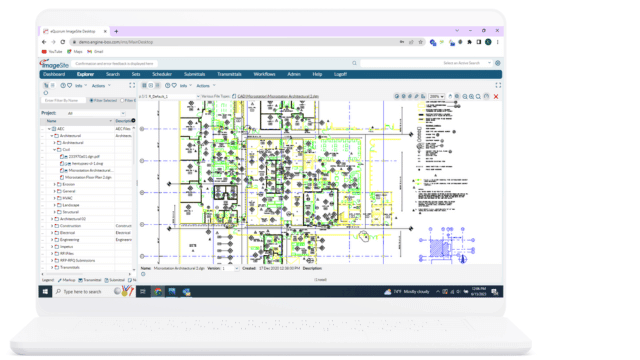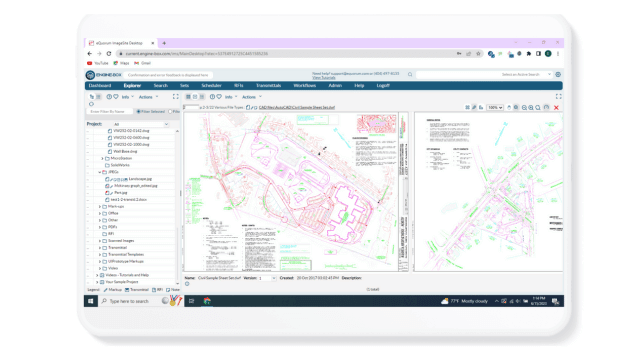COVID-19: Stay Home, Stay Safe, Keep Working
COVID-19: Stay Home, Stay Safe, Keep Working
There is no doubt COVID-19 has given rise to many societal changes. People are staying in, wearing masks, and working from home more than ever before. And, as many states begin to reopen their economy, some people and the organizations they represent are coming up with new and innovative ways to keep business going as usual.
One of the biggest changes facing businesses today is the increase in telecommuting. To reduce the risk of infection, many organizations are requiring workers to either stay home or limit the amount of time spent in the office. While some organizations are well equipped to do so, many have been struggling to operate efficiently, provided they haven’t implemented the proper systems to do so.
Over the years, companies have implemented various software to increase the efficiency and accuracy of projects; however, many have failed to consider one of the most basic needs of their organization. Across all job functions, employees are required to handle files and documents relevant to their work, and some employees don’t have the tools necessary to support the various file types and complex workflows associated with their position, especially during a crisis event like COVID-19.
Companies have become heavily software-dependent, and while some corporations appear to be prepared for a crisis of this nature, many unfortunately are not. Collaboration, while one of the most difficult aspects of working from home, is now especially a stumbling block. For this reason, companies are now more heavily relying on video conferencing, email communication, and Cloud-based file storage to continue with their day-to-day operations.
“According to a recent survey by 8x8 at the end of February, 44% of consumers with full-time jobs have already seen coronavirus impact the way they do business, 55% have canceled travel plans and are having fewer in-person meetings, and 40% are increasing their use of video conferencing.” Laurel Farrer – Forbes Contributor
While Cloud-based file storage systems like Google Drive or Dropbox may appear to be sufficient for the storage and transfer of files, these systems do not provide its users with a way to manage workflows pertaining to a specific document and don’t provide the level of granular security that is needed with engineering files as well as intellectual property of organizations (like drawings and specifications). Typically, working in an office gives users greater transparency into workflow processes, since employees can easily communicate with one another. In contrast, newly remote employees may struggle to keep up with document-centric workflows.
Engine-Box (the Cloud version of ImageSite) is a powerful tool for managing document-centric workflows and the files associated with them. Its purpose is simple - to provide employees with a single location to manage all workflows, documents, communications, transmittals, and RFIs/submittals tied into projects. In addition to its primary functions, Engine-Box also helps users control file versions and provides audit trails for administrators and analytical reviews, to ensure their confidential documents are being handled properly and securely.
“The worst approach to dealing with a remote workforce is to hover over employees and micro-manage them. This will only irritate employees and increase turnover. Instead, a workflow system facilitated by technology can generate positive results, while providing analytics that indicate employee compliance.” Tess Taylor – Benefits Bridge
eQuorum is at the forefront of innovation, especially when it comes to managing telecommuters. Now, with roughly one-third of the American population working from home, eQuorum is dedicating its efforts to helping other companies innovate as well.
For a limited time, eQuorum is offering a free 60-day trial of Engine-Box. Fill out the contact form at https://www.equorum.com/contact-us/ to schedule a trial or demo.
Additional EDMS Features
Our EDMS solutions
ImageSite and EngineBox are eQuorum’s robust workflow and document management solutions, created to help workers manage their essential workflows while maintaining complete control over their engineering files and documents. Not only do they provide a secure collaboration site for workers, but they also help organizations manage document distribution with third parties like vendors, contractors, and customers. Both systems are offered at a competitive price, enabling organizations to get a quick return on their investment by providing the features and functionality needed to help organizations improve efficiency, productivity, and collaboration. Companies can choose from concurrent user subscriptions or named user subscriptions, ensuring organizations have subscription options that make sense for their business.

ImageSite®
Our single source engineering workflow and document management system. Built in HTML5 so there is no software to deploy to client computers or mobile apps to download. Offered as an On-premise or Private Cloud system.
EngineBox™
EngineBox is a cloud based workflow and document management version of ImageSite that resides outside the corporate network.
Our EDMS solutions
ImageSite and EngineBox are eQuorum’s robust workflow and document management solutions, created to help workers manage their essential workflows while maintaining complete control over their engineering files and documents. Not only do they provide a secure collaboration site for workers, but they also help organizations manage document distribution with third parties like vendors, contractors, and customers. Both systems are offered at a competitive price, enabling organizations to get a quick return on their investment by providing the features and functionality needed to help organizations improve efficiency, productivity, and collaboration. Companies can choose from concurrent user subscriptions or named user subscriptions, ensuring organizations have subscription options that make sense for their business.

EngineBox™
EngineBox is a cloud based workflow and document management version of ImageSite that resides outside the corporate network.
The eQuorum Customer Promise
In 2005, eQuorum developed the first all browser-based EDMS. The system, although for on-premise use, was still created to remove client software and JAVA from user computers and allow users to have a single viewer based on the simple navigation functionality of browsers. Today, eQuorum provides that same application in a private Cloud or a SaaS Cloud option. We can do this because we are, and have always been, browser-based, understanding the enhanced speed, security, and usability of this technology.
With the abundance of document management systems on the market today, there’s no doubt that choosing the right Cloud document management software can be a difficult decision. eQuorum is here to provide a comprehensive, powerful, and most importantly – affordable Cloud document management solution. We believe in providing real value to our customers by eliminating unnecessary costs, providing industry-leading functionality, and equipping your team with the right tools using cutting edge technology to bring your products to market faster.
eQuorum®
We specialize in engineering workflow and document management. Our comprehensive, yet easy-to-use software provides the solution to manage data from design to manufacturing and production, to sales, support and administration.